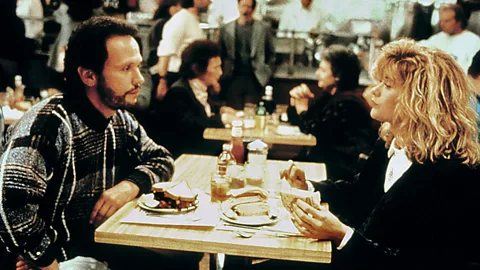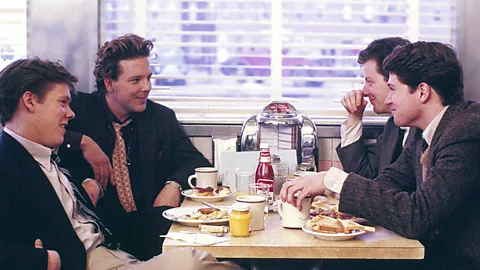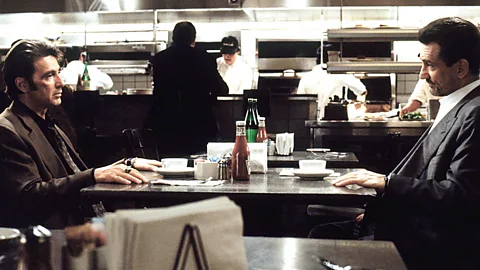The diner: ‘As American as apple pie’

The leather booths and aluminium lines of the diner are staples of US cinema. But why do film-makers use them so frequently? Stephen Smith takes a look.
Which instantly recognisable American landmark has appeared in more movies than any other? The White House? The Statue of Liberty? My hunch is that it’s the diner. Think of Meg Ryan making her fellow patrons wonder what’s in the chef’s special in When Harry Met Sally. Or the moment in Goodfellas when Ray Liotta’s hopped-up gangster is out to lunch with Robert De Niro and becomes convinced he’s about to get killed, Martin Scorsese’s camera pitching and yawing around his banquette in sympathy with the character’s paranoia. And you need look no further than this years’ clutch of Oscar hopefuls for more key scenes set in all-American eateries. Miles Teller, the put-upon drumming tyro in Whiplash, courts his girl at a cosy table, and later picks a similar spot to let her down easy when he tells her there’s room for only one love in his life and it’s not her, it’s jazz.
But why is the highway pit stop on the itinerary of so many film-makers? Well, it turns out that all those muffins are really a MacGuffin, to use Alfred Hitchcock’s phrase for a plot device. In other words, everyone goes to the diner. Josh Olin, screenwriter of A History of Violence, which includes a shoot-up at a luncheonette, told me that the classic art deco cafe is Hollywood’s deus ex machina for getting two or more characters, who might not otherwise meet, under the same streamlined roof. As Olson explained, “The diner is a great place to introduce characters. You don’t need a backstory to tell the audience why they’re there.” It’s the living, lunching proof of Andy Warhol’s great insight into American pop vernacular: like chewing gum and detergent, the coffee shop is used by high and low alike. Incidentally, that’s why no wannabe tenant of the White House would dream of running for office without pulling over for photo opportunities at the great US roadhouse along the way.

This brings us to another lip-smacking attraction of the diner as far as movie-makers are concerned: it’s as American as apple pie. The first of these chow-on-the-go institutions were built by immigrants drawn to the land of the free: Italian tile-setters and marble-workers, German sheet metal workers and French-Canadian carpenters. That clinkered old pan rattling away on the griddle turns out to be a melting pot. The graceful lines of the original aluminium food shacks were borrowed from the dining cars of the railroads that had opened up throughout the United States. Indeed, the all-American origins of the diner go back even further than that, to the chuck wagon that fed cowboys on the range.
An age of innocence
Producers trust that the sight of a mom ‘n’ pop cookhouse acts on the enzymes of the audience like the bouquet of freshly-baked submarine rolls: the receptors for Americana are duly whetted. This sets the mood for a feel-good picture like director Barry Levinson’s breakthrough feature. Levinson liked diners so much he named his film after one. Before Rain Man and Good Morning Vietnam, Levinson scored an Oscar nomination for Diner, which was based on his experiences of growing up in the 1950s, the salad days of drive-by dining. “You know, it was a lot of hours hanging around just shooting the bull about anything under the sun,” recalls Levinson. “Here’s how crazy we were. Say you were on a date and happened to ride by the diner: you’d see whose cars were there and you’d drop off your date and head inside because it would be a much more interesting night.”

The movies also like to cast the diner against type, so to speak, by contrasting its wipe-clean family values with something altogether darker. For many critics, there’s no finer diner picture than The Killers, a 1964 film noir as black and smoky as barbeque sauce. And there could be no other choice of location for a historic meeting between two great screen legends, in a story of good against evil. It was at a t called Mantilini’s in Los Angeles that De Niro and Al Pacino filmed a scene together for the first time in their storied careers. In Michael Mann’s shoot-‘em-up policier Heat, De Niro was the irresistible crime boss, his co-star the immovable cop. One day, like a pair of ladies who lunch, they had coffee together in Beverly Hills. Though the place has undergone several refurbishments since Mann yelled ‘Cut!’, the proprietor kindly sets the table just as the two leading men left it: paper napkins, a bottle of Italian sparkling water, cruet that any self-respecting movie buff would know in a heartbeat. “Guys book this table all the time,“ my waitress told me. “One of them will be De Niro and speak his lines, the other’s Pacino. Then they swap over. Women are mystified but I say to them ‘Do you know Bridget Jones? Well, it’s like that, but for guys.’”

Of course, Mantilini’s of Wilshire Boulevard is a long way from being a greasy spoon: you’d hardly expect Hollywood royalty to put up with that. But then the truth is that the good old-fashioned kerbside kitchen is vanishing from the landscape. If gourmands detect flavours of nostalgia in the story of the diner on screen, it’s because it appears more often at the multiplex than it does in the mall outside. In the real world, many of these fine establishments have been chewed up and spat out by the global fast food franchises. So the next time you’re in the stalls watching a scene set in a dining booth – while slurping on a jumbo soda and inhaling an extra-large hotdog – that ought to be food for thought.
